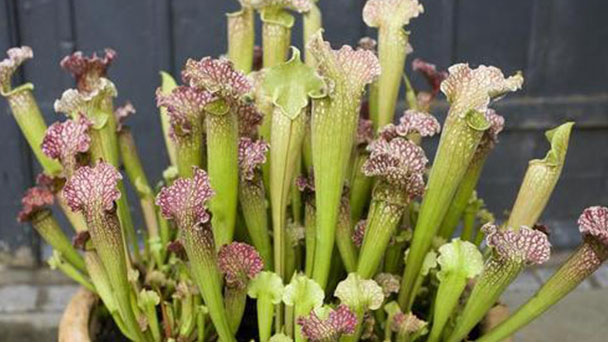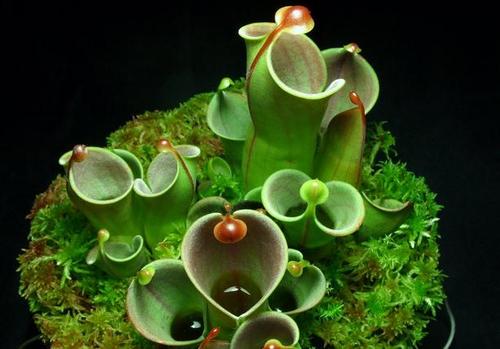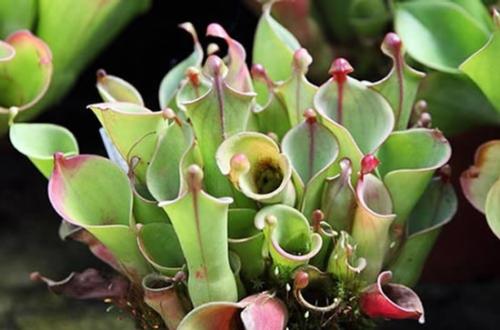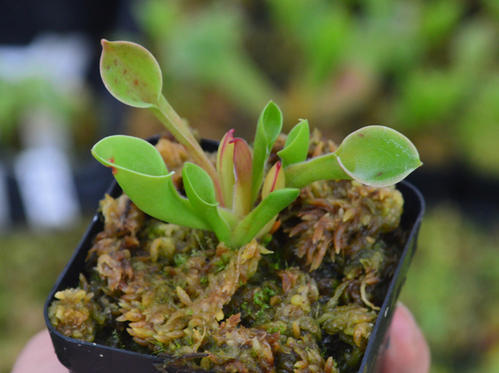Heliamphora (sun pitcher) profile
Written by Maggie
Mar 26 2021

Heliamphora is a relatively larger temperament elegant insectivorous plants, cylindrical vertical or lateral, most colorful have bright spots or reticulate, morphology and nepenthes cages are similar, can secrete juices and digestive juices, the honey lure insects stumble drops in a bottle, bottle in digestive juices will put the insect digestion and absorption. The Heliamphora is produced in the mountain wetlands of South America, the beautiful shape is liked by many players, but because of the higher requirements for planting only suitable for the conditional player collection!
Heliamphora picture

Morphological characteristics of Heliamphora
Heliamphora is a relatively larger temperament elegant insectivorous plants, cylindrical vertical or lateral, most colorful have bright spots or reticulate, morphology and nepenthes cages are similar, can secrete juices and digestive juices, the honey lure insects stumble drops in a bottle, bottle in digestive juices will put the insect digestion and absorption.
The ecological habits of Heliamphora
Survival temperature: 2-32℃
Suitable temperature: 15-25℃
Cultivation substrate: peat, water moss, perlite, sand, etc
Ambient humidity: >;50%
Country of Origin: Venezuela
Adult size: Leaves approx. 10 cm (the maximum size a plant can normally reach as an adult, regardless of what it is sold!)
Planting points: water with low mineral content should be used for watering (such as rainwater, pure water, etc.); Heliamphora likes good light and low night temperature; If you need fertilizer, you can spray more than 1/5 of the indicated concentration!
The species classification of Heliamphora
The genus is composed of 16 species (excluding artificial hybrids), all of which are native to northern South America. Most Heliamphora use symbiotic fungi as a means of digesting and capturing insects. There is not much in the domestic market and not much in Taiwan.
Specific varieties are as follows
Heliamphora chimantensis
Heliamphora elongata
Heliamphora exappendiculata
Heliamphora folliculata
Heliamphora glabra
Heliamphora heterodoxa
Heliamphora hispida
Heliamphora ionasii
Heliamphora minor
Heliamphora neblinae
Heliamphora nutans
Heliamphora pulchella
Heliamphora sarracenioides
Heliamphora tatei
It is difficult to cultivate, requiring high humidity, and some plateau species require low temperature.
How to grow and care for Heliamphora
Soil
Heliamphora has to develop in nutrient negative soil. This is due to the fact they stay in grasses and no longer certainly applicable soil in their habitat. When developing Heliamphora at home, make certain that the soil is well-drained and no longer soggy.
The great soil for Heliamphora is a combination of 1:1:1 perlite, lava rock/sand and peat/sphagnum moss. You can additionally add some orchid bark.
Water
In their habitat, Heliamphora flowers get a lot of water from overhead each day – with each day rainfalls and excessive humidity. When developing at home, water the vegetation every day and maintain the soil moist at all times.
If you don't have time to water daily, water them each and every 2d day however hold a saucer on the backside of the container. Water from overhead with deionized, mineral-free, reverse-osmosis water or rainwater. Read extra on reverse-osmosis water filtering gadgets and their advantages here.
Also, mist your plant at least a few instances a week, to wash off any collecting fungi.
Container
The fantastic kinds of containers for Heliamphora flowers are plastic or ceramic ones with drainage holes on the bottom. Choose 4-6 inch pots for younger Heliamphora plants, and 8-10 inch containers for mature plants.
Another proper container desire is ceramic pots with backside holes and saucers like this. You can additionally location your flowers in a terrarium, or greenhouse, however solely in pots. Proper airflow is very important.
Temperatures
Heliamphora plant life requires cool-warm daylight hours temperatures and cool-cold nights. In the herbal habitat, on the mountaintops, it is foggy and cool. Daytime temperatures ought to vary from 60-85 ranges Fahrenheit (15.5-29 Celsius), however, attempt to hold temperatures in the mid-range. Nighttime temperatures need to vary between 50-60 ranges Fahrenheit (10-15.5 Celsius).
In winter, you can limit temperatures even more, however no longer decrease than forty-five ranges F (7.2 levels Celsius). However, these low temperatures will sluggish down plant growth.
Light
Heliamphora plant life wants full solar or full light. If developing indoors and besides the opportunity of supplying the plant with sunlight, use synthetic plant lights.
Humidity
Heliamphora flora naturally stays in excessive humidity areas with regular fogs. At home, make positive to preserve them in a spot with excessive humidity (60% or more). Misting flora and the usage of a humidifier can assist extend humidity levels.

How to grow Heliamphora outdoors
Don't plant Heliamphora exterior if the temperatures don’t shape the above requirements. Only if your local weather presents heat sunlight hours temperatures and low hours of darkness temperatures + excessive humidity, then you can have the plant outside.
Growing Heliamphora in a greenhouse
Growing the Sun Pitchers in a greenhouse may be a desirable idea, however solely in a cool house. High temperatures above eighty-five levels will damage the plants.
What is more, you will want to cool the greenhouse to low temperatures at night. The higher notion is to have a mini walk-in greenhouse like this or something similar, to accommodate these plants. Portable greenhouses are additionally good.
Growing Heliamphora in a terrarium indoors
If you determine to develop Sun Pitchers in a terrarium, make certain to have synthetic plant life lights on the pinnacle of a container. While you will want excessive humidity levels, make positive to open the lid very frequently to let the sparkling air in.
Heliamphora requires exact ventilation. Choose a massive mini-greenhouse tank that will serve as a terrarium and region the plant life in the pots inside.
You can area the terrarium in the office, for example, the place sunlight hours temperatures don’t want to be supported. But at night, you can cool the terrarium with ice packs and airflow (open the vent).
If your vicinity your terrarium in a bloodless basement, you can warmth it all through the day if wanted with a heating pad like this. Make certain temperatures are the highest quality in the course of the nighttime. If the usage of a heating pad, you want to join it to a thermostat to make certain that temperatures are correct.
How to propagate Heliamphora
You can pollinate a girl plant with male pollen to obtain seeds, however, it will take few months to produce seeds, then a few weeks to germinate them, and then 3-4 years for a seed to come to be a younger plant.
You can additionally propagate Heliamphora by way of diving the plant at the rhizome point so that a new plant has roots. Tissue subculture is additionally every other way to propagate Heliamphora.

Latest Updated
- Benefits of Bugleweed - 7 Science-backed Health Benefits
- Bugleweed Dangers & Side Effects - Is It Poisonous?
- How to Plant Evergreen Trees - What You Should Know
- When to Plant Evergreens - Grow Guide for Evergreen Trees
- 12 Wonderful Evergreen Shrubs for Your Garden
- 12 Popular Evergreen Plants with Pictures for Beginners
- When And How To Prune A Lilac Bush Like a Pro
- How to Grow & Care for Lilac Vine (Hardenbergia Violacea)
- Japanese Lilac Tree (Syringa Reticulata) Care & Propagation Guide
- Shumard Oak Pros and Cons - What to Know
Popular Articles
- Winter maintenance of Antirrhinum Majus
- How to Grow Terminalia Mantaly Tree
- How to Grow and Care for Crossostephium Chinense
- How to grow Antirrhinum Majus in spring
- Peristeria Elata (Dove Orchid) Profile: Info & Care Guide
- Underwatered Snake Plant (Sansevieria Trifasciata) - Signs And How To Fix
- How to Care for Brazilian Jasmine Plant (Mandevilla Sanderi)
- How to Grow & Care for Graptopetalum Purple Delight in Summer
- Rosa Chinensis (China Rose): Plant Growing & Care Tips
- How to Care for Baby Sun Rose (Aptenia Cordifolia)